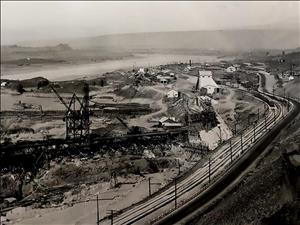On December 8, 1930, the community of Rock Island on the east bank of the Columbia River in Douglas County is officially incorporated as a town of the fourth class when a certified copy of the county commissioners' order approving the incorporation is filed with the Washington Secretary of State's office. Some gold miners reached the Rock Island area in the 1850s, the first homesteaders settled there in the 1880s, and arrival of the Great Northern Railway brought some growth in the early 1890s. Then construction of the Rock Island Dam just downriver beginning in 1930 promoted further growth and residents sought to incorporate. On November 21, 1930, voters favor incorporation by a large majority, 43 votes for and 9 against, and elect the first town officers. On November 24, county commissioners approve an order certifying the election results and ordering the incorporation, which is filed with the Secretary of State on December 8.
In Favor of Incorporation
The search for gold along the Columbia brought the first newcomers, many of them miners from China, into the area in the 1850s. James Keane (1850-1939) made the first known homestead claim in what would become Rock Island in 1887. Before long he and others were establishing businesses to serve workers of the Great Northern Railway, which in 1890 announced plans to construct the first railroad bridge across the Columbia there. Even before the bridge was completed in 1893, Charles Boyle Reed (1838-1909) became Rock Island's first postmaster on February 10, 1892, operating the post office from his home.
Growth slowed after the bridge was completed and the railroad workers moved on, but several decades later another pioneering construction project spanning the river brought another round of growth. In 1928 the Puget Sound Power & Light Company (Puget Power) announced plans to build a hydroelectric dam across the river at the Rock Island Rapids just downstream from the town named, like the rapids, for the large rocky island in the center of the rapids. It would be the first dam, and first hydroelectric project, built on the Columbia. The project was approved in 1929 and work got underway in early 1930.
It was already apparent that the project would bring further growth and development to the community just upriver, and by then Rock Island residents were ready to organize a municipal government and incorporate the town. A petition was drawn up and presented to the Douglas County Board of County Commissioners seeking incorporation of the "Town of Rock Island." The board set a date of November 21, 1930, to hold an election for those living within the boundaries of the proposed town to vote on the incorporation question.
The results were overwhelmingly in favor of incorporation. When the votes were tallied, there were 43 in favor and 9 against. The results were returned to the Board of County Commissioners, which on November 24, 1930, certified the election and ordered the incorporation of the Town of Rock Island as a municipal corporation of the fourth class. Four days later, Douglas County Auditor L. L. Sellers certified a copy of the board proceedings and order for filing with the Secretary of State's office. Rock Island's incorporation became official on December 8, 1930, when the certified documents were filed in the office of the Secretary of State.
First Elected Officials
Rock Island first elected officials were chosen in the same November 21 election in which the incorporation was approved. A. A. Elmore was elected mayor; Allan E. McLean (1874-?) became the first treasurer; and J. W. Fields, C. M. Gentzler, Merral Clifford Ahneman, Ed R. Young, and Joe Smith were the first members elected to the town council. All the successful candidates won by large margins.
Not all that much is known about A. A. Elmore who served as Rock Island's first mayor. Oklahoma born, he served as state president for Washington and Idaho farmers unions, engaged in real estate, was member of numerous wheat-growers organizations, and served as pastor of a church in Thorp.
Rock Island's rapid growth during dam construction, which had prompted the incorporation, did not last after the dam was complete. Rock Island grew at a slow snail's pace and its population increased and decreased over the years. Expansion of the dam's generating capacity in the 1950s and 1970s again boosted economic growth in the area. The population grew some more in the new century, reaching 1,570 as of 2023.

